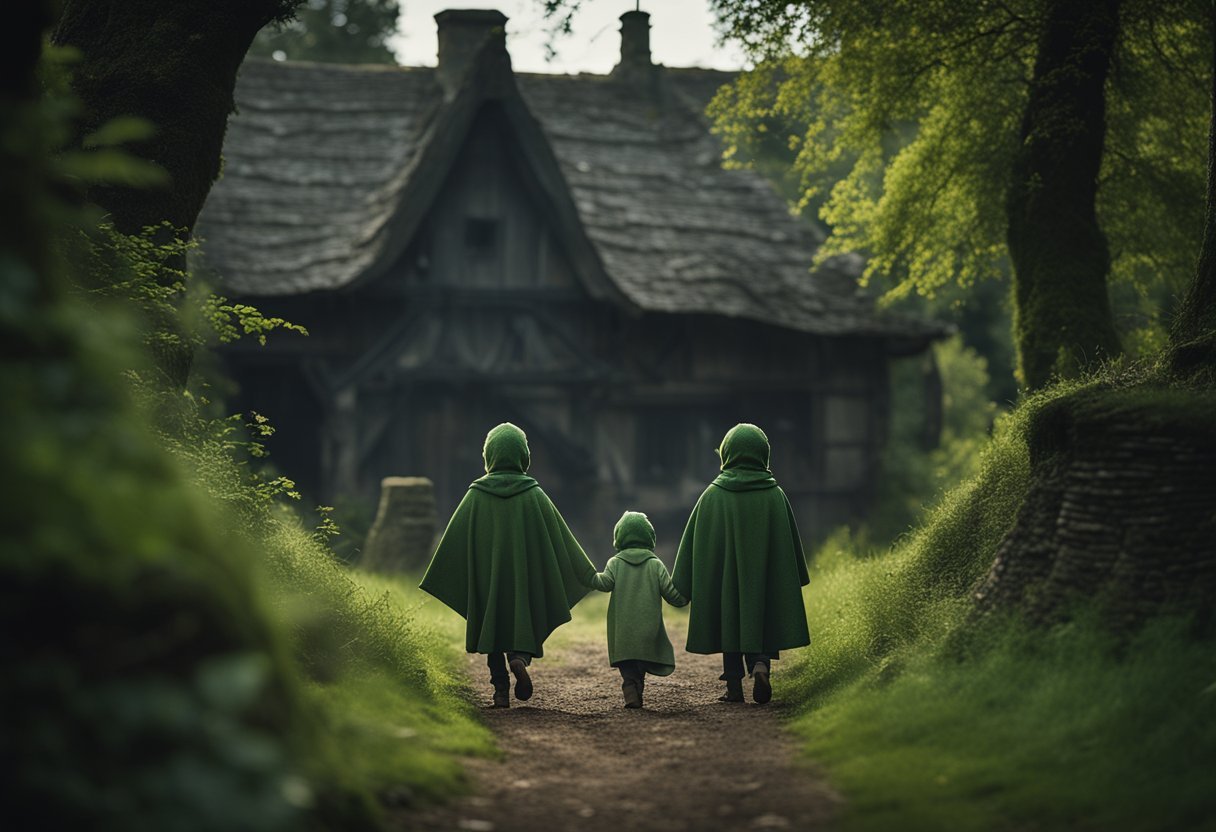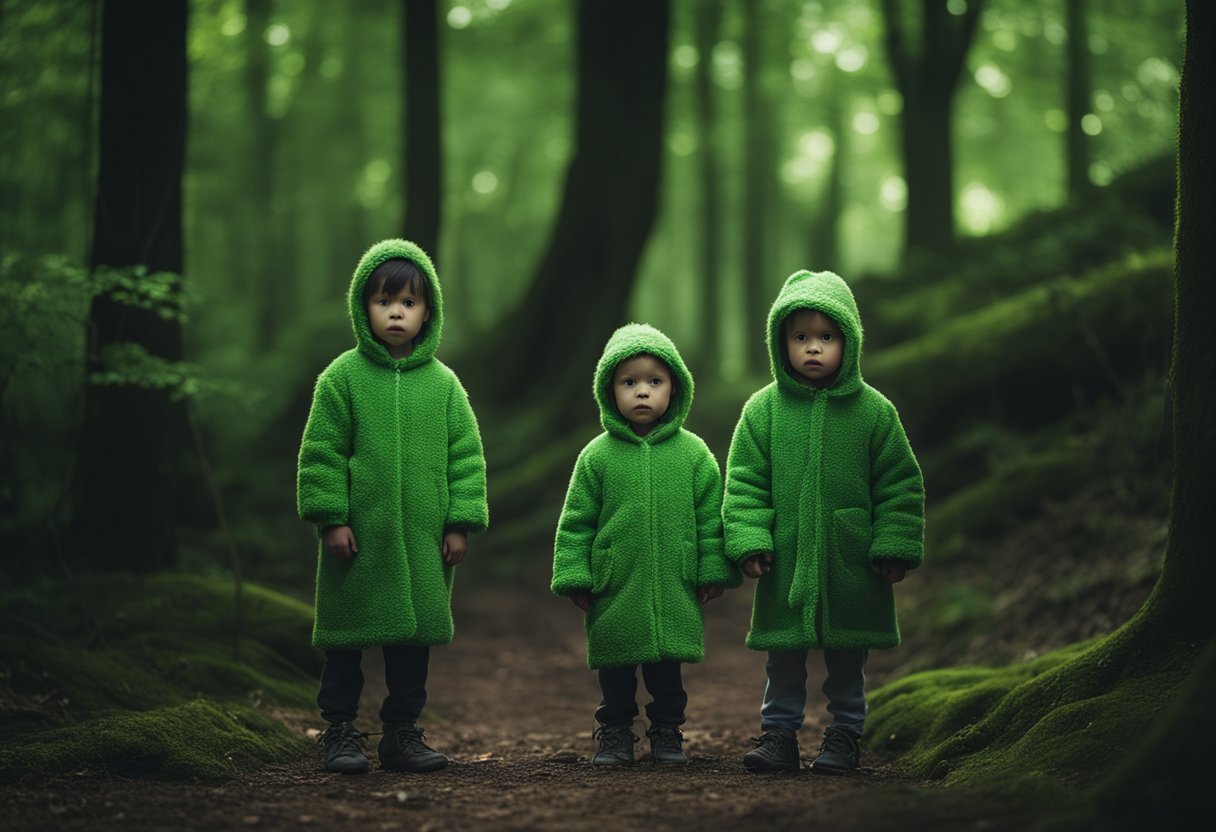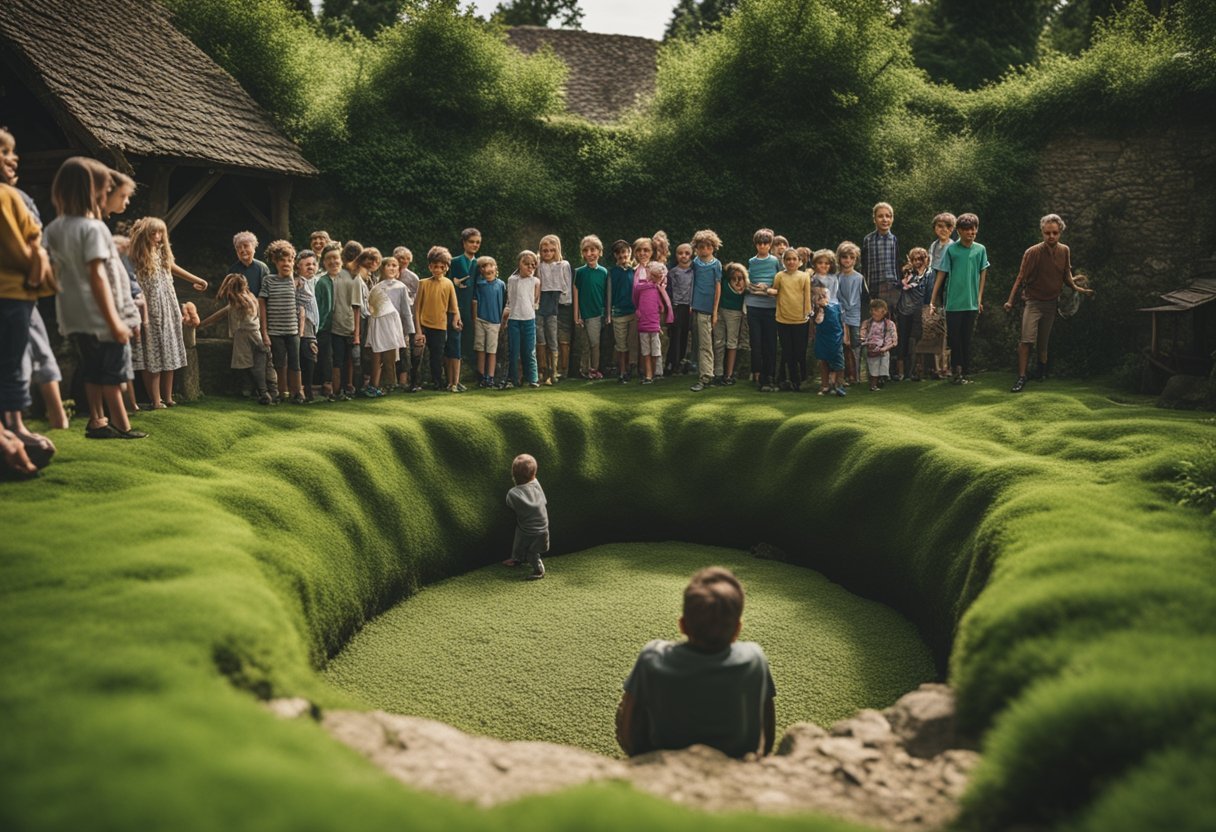The story of the Green Children of Woolpit has intrigued historians and folklore enthusiasts for centuries. In the 12th century, two children appeared in the village of Woolpit, Suffolk, speaking an unknown language and exhibiting unusual green skin. The tale raises questions about their origins, leading to theories of extraterrestrial influences or a more earthly explanation involving cultural displacement or environmental factors.

As the narrative unfolds, the children’s strange behaviors and characteristic features draw further examination, prompting discussions about the societal implications of integrating outsiders. The tale has evolved from a local anecdote into a significant part of cultural history, influencing literature and folklore beyond its geographical roots.
Exploring this mysterious event reveals the interplay between history and mythology, reflecting humanity’s enduring fascination with the unknown. The Green Children of Woolpit serve as a reminder of how stories connect cultures and spark curiosity about our shared narratives.
Key Takeaways
- The Green Children of Woolpit present a captivating historical mystery.
- The story has sparked various theories and interpretations throughout history.
- Its cultural impact continues to resonate in literature and folklore.
Historical Context
The tale of the Green Children of Woolpit is best understood against the backdrop of 12th-century England, a time marked by significant political instability and social change. This period, particularly during the era known as The Anarchy, greatly influenced life in rural regions such as Suffolk.
12th Century England
In the 12th century, England was characterized by feudalism and a predominantly agrarian society. Land ownership determined social status, with the nobility controlling vast estates and the peasantry working the land. This period was marked by the tension between various noble families vying for power.
The political landscape was tumultuous, leading to frequent conflicts and local skirmishes. Such instability often affected rural communities, where people relied heavily on tradition and local governance.
The Anarchy Era
The Anarchy (1135–1154) refers to the civil war between supporters of King Stephen and those of Empress Matilda. This conflict caused widespread disruption across England, with local lords acting independently and often violently.
Communities faced threats from marauding bands and shifting allegiances. In this chaotic environment, tales of the unusual—such as the story of the Green Children—could spread easily, reflecting both the anxieties and curiosities of the populace.
Life in Suffolk
Suffolk, like much of rural England, was primarily agricultural. Villages were small, and communities were tightly-knit. The economy depended on farming, with staple crops like wheat and barley dominating production.
Local folklore played a significant role in community life, serving as a means of understanding the world. The arrival of the Green Children was undoubtedly influenced by such cultural narratives, which may have mingled truths and legends, accentuating local fears and fascinations.
This combination of political strife, agrarian life, and vibrant local traditions set the stage for the emergence of the tale of the Green Children of Woolpit.
The Tale Unveiled

The story of the Green Children of Woolpit features unusual characters and curious circumstances that have intrigued historians for centuries. The accounts provide insight into the origins and experiences of these mysterious figures.
Discovery at Woolpit
In the 12th century, the green children were reportedly discovered near the village of Woolpit, Suffolk. According to the chronicles, they appeared in the midst of the harvest, emerging from a wolf pit. Local villagers were astonished to find two children with green-hued skin, speaking an unknown language.
William of Newburgh, a notable chronicler, documented this occurrence in his work Historia Rerum Anglicarum. He noted how the children were taken to the local lord, Richard de Calne, who sought to understand their origins. Their strange appearance and language set them apart from the villagers, sparking curiosity and speculation about their background.
Description by Chroniclers
The accounts provided by chroniclers like William of Newburgh and Ralph of Coggeshall shed light on the distinctive characteristics of the children. Newburgh described their skin as being green and their clothing made from unfamiliar materials, hinting at a connection to a foreign land.
According to Ralph of Coggeshall’s Chronicon Anglicanum, the children claimed to come from a place where the sun never shone, indicating a mystical environment. Their eventual assimilation into local culture, including learning to speak English, raised more questions about their original home. The story continues to captivate the imagination of historians and scholars alike, leaving a lasting legacy in folklore.
Mysterious Characteristics

The Green Children of Woolpit exhibited several peculiar traits that have intrigued historians and folklorists alike. Their unusual green skin and the enigmatic language they spoke are particularly notable aspects of their story. Additionally, their strange clothing raises questions about their origins and experiences.
The Green Skin Phenomenon
The most striking characteristic of the Green Children was their green skin, which has led to various interpretations. Some theories suggest that this may have been a manifestation of chlorosis or hypochromic anemia, conditions associated with a deficiency in hemoglobin. These medical conditions can impart a greenish hue to the skin, resembling the children’s reported appearance.
Despite the medical explanation, the fantastical element of their story has captured public imagination. As they appeared in the 12th century in Woolpit, England, their skin color contributed to the notion of an otherworldly origin. Theories range from them being extraterrestrial beings to symbols of exoticism in medieval folklore.
Language and Clothing
The Green Children were reported to have spoken an unknown language that left adults bewildered. This language was distinct and unintelligible to the villagers of Woolpit, adding to the mystery surrounding their origin. Some believe it might have been a dialect from a distant region or even an invented form of speech.
Their clothing was described as strange and notably different from typical attire of the time. The garments were ill-fitting and did not resemble the local fashion. This unusual style further fueled speculation regarding their background. Some interpretations suggest they may represent other cultures or serve as allegorical figures in folklore, illustrating the clash between the familiar and the unknown in their time.
Theories and Interpretations

The story of the Green Children of Woolpit has spurred a variety of theories and interpretations over the years. These range from historical and medical insights to extraterrestrial hypotheses and folkloric perspectives.
Historical and Medical Speculations
Many theories suggest that the Green Children may have been Flemish immigrants or local migrants suffering from malnutrition. Such circumstances could explain their green hue, which some medical experts attribute to a condition like chlorosis, a form of anemia. This condition can give the skin a greenish tint due to iron deficiency.
Further speculation points to possible social factors, as these children were discovered during a time of upheaval in England. The historical context of the 12th century included many displaced individuals due to war and famine. This situation may have created a backdrop for the children’s sudden appearance in Woolpit.
Extraterrestrial Hypotheses
The notion that the Green Children were extraterrestrial beings is a popular but more speculative interpretation. Some theorists suggest that their appearance aligns with common science fiction narratives involving aliens and unexplained phenomena. Supporters point to linguistic barriers and unusual clothing as indicators of foreign origins, potentially across different realms.
While the idea captivates popular imagination, it lacks concrete evidence. Nonetheless, it has led to various interpretations regarding the nature of life beyond Earth, contributing to a larger discourse on alien encounters throughout history.
Folkloric Perspectives
In folklore, the Green Children have often been associated with fairies or other mythical beings. Tales of fairy sightings often involve children who possess strange characteristics and exhibit behaviors unlike those of ordinary humans. These stories reflect societal fears and beliefs about otherworldly creatures during medieval times.
The Green Children’s story embodies a narrative of wonder, exploration, and fear of the unknown. It serves as a reminder of the rich tapestry of folklore that informs cultural identities, encapsulating human fascination with what lies beyond the familiar. Through this lens, the children’s tale becomes a symbol of deeper cultural anxieties and curiosities.
Cultural Impact

The story of the Green Children of Woolpit has left a significant mark on both literature and folklore, stirring fascination and mystery around their origins. Their tale serves as a lens through which English culture can be examined, intertwining themes of identity and belonging.
Influence on Literature
The Green Children have inspired various literary works, prompting authors to explore themes of alienation and cultural diversity. In The Anatomy of Melancholy, Robert Burton references the phenomenon, using the children to highlight the era’s curiosity about the unknown. Their narrative has been adapted into fables and stories, usually reflecting human experiences in unfamiliar worlds.
Many contemporary writers continue to draw on this tale, recognizing the enduring power of its themes. The juxtaposition of the green children’s otherness against the backdrop of a small English village adds layers of intrigue, influencing genres such as fantasy and speculative fiction. This transformation signifies how folklore can evolve within literature over time.
Legacy in Folklore
The legacy of the Green Children in English folklore resonates with ongoing themes of mysterious origins. The story remains a point of interest, symbolizing the complexities of cultural integration in society. Within local tradition, they symbolize the fascination with the supernatural, encouraging community storytelling that enriches cultural heritage.
Tales of strange beings, like the Green Children, illustrate the medieval mindset—the interplay of reality and the mystical. They have been associated with various interpretations, from allegories of otherness to reflections of societal fears about the unknown. As folklore endures, the Green Children remain an emblem of the mystery that continues to captivate audiences and scholars alike.
Aftermath and Conclusion
The arrival of the Green Children in Woolpit had significant implications for their integration into local society and the broader narrative of folklore in East Anglia. Their experiences highlight themes of adaptation, bewilderment, and the blending of myth with historical context.
Adaptation to Local Life
After being discovered, the Green Children were baptized and quickly adapted to life in the village. Initially, they struggled with local foods, particularly raw beans, which they found unpalatable. Instead, they developed a preference for broad beans, which they consumed with enthusiasm.
As they learned the English language and customs, their peculiar origins sparked curiosity. Their story of coming from a land enveloped in perpetual twilight added an element of mystique that captivated the local population. Eventually, they assimilated into East Anglian society, with one child, later named Richard, integrating so well that he became a prominent member of the community.
The Green Children’s Legacy
The tale of the Green Children echoes throughout English folklore and has become a significant cultural marker. Their story is often linked to the Battle of Fornham, an event that impacted many lives in the area, including the children’s past.
Moreover, the Green Children’s experiences raised questions about identity and belonging. They symbolize the fears and fascinations of outsiders in medieval England, making their legacy relevant beyond their time. Their narrative continues to inspire discussions around folklore, superstition, and historical interpretation in places like King’s Lynn and the wider region. This enduring fascination highlights the intersection of myth and reality in the historical consciousness of East Anglia.
Frequently Asked Questions
The story of the Green Children of Woolpit raises various intriguing questions. Insights into their language, origin, pigmentation, fate, and connections provide a clearer understanding of this unusual tale.
What language did the children of unusual skin color from Woolpit speak?
The Green Children reportedly spoke a language that was unfamiliar to the people of Woolpit. Some accounts suggest it was a form of a local dialect or an unknown tongue, which made communication difficult initially.
From where are the peculiarly colored children of Woolpit believed to have originated?
The exact origin of the Green Children remains uncertain. Folklore suggests they may have come from a mythical land known as St. Martin’s Land, a place described as being dimly lit and inhabited by people with green skin.
What is the prevalent theory behind the children’s pigmentation found in Woolpit?
Various theories attempt to explain the children’s green pigmentation. One commonly proposed explanation is that their skin color resulted from a diet of green plants or insufficient exposure to sunlight.
What ultimately became of the children found in Woolpit with green-tinged skin?
After their discovery, the children gradually acclimatized to their new environment. The boy is said to have died shortly after, while the girl survived, learned English, and eventually integrated into the local community.
Are there any descendants known of the children who appeared in Woolpit with distinct skin color?
There are no documented descendants of the Green Children. The tale of their existence seems to have concluded with their integration into Woolpit society.
How are the Woolpit children with unique skin coloration connected to St. Martin?
The connection to St. Martin arises from the suggestion that the children hailed from a place linked to this saint. Some narratives imply that the children’s mysterious home may have been influenced by the legend of St. Martin, adding to the folklore surrounding their story.


